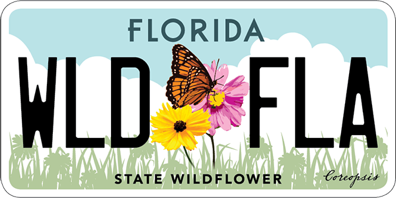Search
By Publication Type
By Resource Type
Loblolly bay
Loblolly bay (Gordonia lasianthus) is an attractive evergreen tree found in swamps, bayheads and cypress domes throughout much of Florida. Its fragrant showy flowers bloom spring through summer and attract a variety of pollinators.
Christmasberry
Christmasberry (Lycium carolinianum) gets its common name from the many bright red, egg-shaped berries it produces in December. While toxic to some animals, they are favored by many birds.
Fragrant ladiestresses
Fragrant ladiestresses (Spiranthes odorata) is a semi-aquatic to aquatic perennial orchid. It occurs naturally in swamps, wet pinelands and seepage slopes throughout Florida.
Sea lavender
Sea lavender (Heliotropium gnaphalodes) is an evergreen shrub found in dunes and thickets on the Atlantic coast of Central and South Florida. Its small but showy flowers emit a subtly sweet scent and attract many pollinators.
Wand goldenrod
Wand goldenrod (Solidago stricta) persists in wetter environments than most of our other native goldenrods, occurring naturally in wet flatwoods and prairies.
Lopsided indiangrass
Lopsided indiangrass (Sorghastrum secundum) is a robust perennial bunchgrass that occurs in pinelands, sandhills and flatwoods. Throughout most of the year, it is rather indistinct. But in late summer, it produces tall, dramatic flower spikes.
Wild coco
Wild coco (Eulophia alta) is a terrestrial orchid found in hydric hammocks, hardwood swamps, wet flatwoods, marshes and open disturbed sites in Central and South Florida.
Narrowleaf silkgrass
Narrowleaf silkgrass (Pityopsis graminifolia) blooms late summer through early winter in sandhill, flatwoods and scrub habitats throughout the state. It has brilliant yellow flowers and silvery leaves.
Gulf County Public Library at Port St. Joe Native Plant Garden
The Gulf County Public Library at Port St. Joe was selected to pilot the Seeds of Knowledge Library Demonstration Garden Grant in spring 2025.
Hernando County Library Native Plant Garden
The Hernando County Public Library in Brooksville was selected to pilot the Seeds of Knowledge Library Demonstration Garden Grant in spring 2025.
White indigoberry
White indigoberry ( Randia aculeata) is an evergreen flowering shrub or small tree found in pine rocklands and coastal strands and hammocks in Central and South Florida.
Fort White Branch Library Native Plant Garden
The Fort White Branch Library in Columbia County was selected to pilot the Seeds of Knowledge Library Demonstration Garden Grant in spring 2025.
Bay County Public Library Native Plant Garden
The Bay County Public Library was selected to pilot the Seeds of Knowledge Library Demonstration Garden Grant in spring 2025.
Florida paintbrush
Florida paintbrush (Carphephorus corymbosus) blooms from mid-summer into fall, attracting butterflies and other pollinators. It occurs naturally in sandhills, pine flatwoods, scrubby flatwoods, mesic flatwoods and ruderal areas.
City of Tavares Public Library Native Plant Garden
The City of Tavares Public Library in Lake County was selected to pilot the Seeds of Knowledge Library Demonstration Garden Grant in spring 2025.
Firebush
Firebush (Hamelia patens var. patens) is a hardy shrub to small tree. It produces clusters of bright orange to red tubular flowers that are filled with nectar, attracting butterflies and hummingbirds.
Grassleaf coneflower
Grassleaf coneflower (Rudbeckia graminifolia) has brick-red solitary flowers that bloom in summer. It is endemic to the Florida Panhandle and occurs naturally in wet savannas.
Wild petunia
Wild petunia (Ruellia caroliniensis) typically blooms late spring through early fall, attracting a variety of pollinators. It is also a host plant for the White peacock butterfly.
Moonflower
Moonflower (Ipomoea alba) occurs naturally along the margins of wet to moist hardwood hammocks, mangrove forests and swamps. Its night blooming flowers attract and are pollinated by moths.
Rosy camphorweed
Rosy camphorweed (Pluchea baccharis) is a summer-blooming wildflower found in wet habitats throughout Florida. Its pink flowers are particularly attractive to small butterflies, bees and other dainty pollinators.
Joe Pye weed
Joe Pye weed (Eutrochium fistulosum) is a robust summer-blooming wildflower that attracts a wide variety of pollinators and is a favorite of butterflies. The seeds are consumed by small birds.
Tall ironweed
Tall ironweed (Vernonia angustifolia) is a robust perennial wildflower that blooms in summer and fall, attracting a variety of pollinators, especially butterflies.
Coral honeysuckle
Coral honeysuckle (Lonicera sempervirens) flowers are attractive to many butterflies, and hummingbirds find them irresistible. Birds such as Northern cardinals enjoy the bright red berries.
Bushy seaside oxeye
Bushy seaside oxeye (Borrichia frutescens) blooms year-round, keeping our coastline in color and attracting butterflies and other pollinators. Its seeds provide food for birds and other small wildlife.
